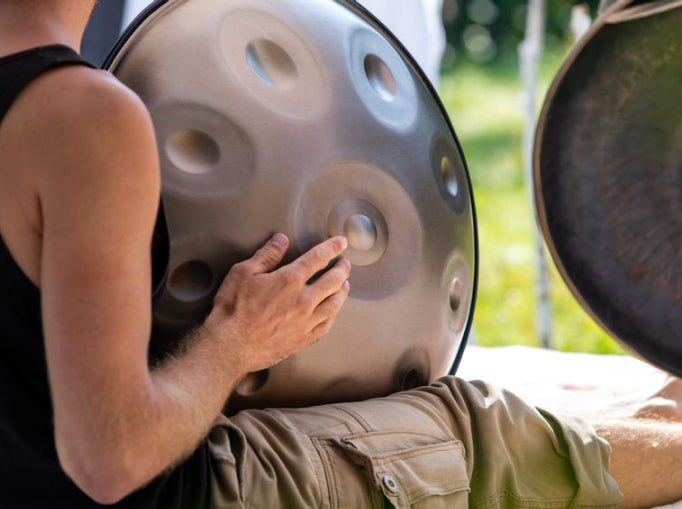
432 Hz – Myth or Truth?
Have you heard about 432hz music?
Much more than a number, this number has been surrounded by mysticism, cosmic theories, and promises of healing. In alternative circles, it's attributed with almost magical qualities: it calms the heart, it attunes the soul to the Earth, it resonates with the geometry of the universe. For some, it's a gateway to the sacred; for others, just another number on the dial. But beyond myth or trend, what does it really mean that a song is tuned to 432 Hz? Is it possible that the frequency of a note influences how we experience music... or even how we inhabit the world?
In this article, we'll explore the heart of this question. Not from a place of fantasy, but not from a place of pure skepticism either. We offer a clear and intriguing journey through history, perception, and vibrational awareness. Because maybe—just maybe—understanding music through frequency is another way of understanding ourselves.
Standard musical tuning (A = 440 Hz) versus “cosmic tuning” (A = 432 Hz) is a matter of debate. In fact, 432 and 440 are simply numbers in our decimal system, with no inherent universal meaning. As VicManMusic explains, our unit of Hertz (cycles per second) is arbitrary: we could measure oscillations per minute or another scale, giving different numbers for the same thing. In nature there is no absolute pitch, and Any frequency can be related to natural patterns if desired.(1). That is, the fact that we use 432 Hz or another value is based on human conventions, not on a pre-established “cosmic mystery.”(1).
Tuning to 432 Hz does not change the basic musical structure, only the pitch of all the notes. The number “432 Hz” usually refers to the frequency of the note A (A4). If we set A4 to 432 Hz, all other notes in the scale are shifted slightly downwards(2)For example, with A4=432 Hz a Si (B4) would vibrate around 484.90 Hz instead of 493.88 Hz(2). So, musically, 432 Hz is just “another reference point”: the piece sounds a little lower than at 440 Hz, but it’s the same music at a different frequency. Furthermore, our listening preferences depend on the familiarity Cultural: As experts point out, if we have listened to music tuned to 440 Hz all our lives, we will tend to find it familiar, while 432 Hz might seem "new" to us.(2).

Brief history of tuning
Historical variation. Until the 20th century, there was no standard tuning: each region and instrument had its own. English Handel and German Mozart, for example, tuned their A's at ~423–422 Hz (almost a half tone lower than the modern A)wam.hrOrgans with A above 500 Hz or below 400 Hz have been documented at different times.wam.hrIn 1859 France recommended A=435 Hz, and by 1925 many uses were close to 440 Hz, but there was no global consensus.wam.hrwam.hr.
1910–1939: Movements towards 440 Hz. In 1910 the manufacturer John C. Deagan convinced the American Federation of Musicians to adopt A=440 Hz as the standard for orchestraspas.orgIn 1936 the American Standards Association (ANSI) also recommended 440 Hz. Finally, in 1939 An international conference decided to officially base concert pitch on A=440 Hz(3)From then on, the BBC and other media spread this value, and in 1955 and 1975 the ISO reaffirmed it.(3).
Nazi myth and conspiracies. There is a rumor that the Nazis or Goebbels imposed 440 Hz to control minds, but there is no historical evidence of it(4)The adoption of A=440 was based on practical and musical criteria (unifying groups and standardizing instrument making)(4), not propaganda. Any connection is mere speculation with no real basis.(4).

432 Hz vs. 440 Hz: Perceptions and Effects
Perceived loudness. Musically, playing a piece at 432 Hz instead of 440 Hz will make it sound very slightly more serious. To the untrained ear, the difference is minimal. In fact, studies indicate that many people take a while to notice the variation without prior examples.(2)Initially it may seem “flat” or different, but after getting used to it the music sounds normal and coherent.(2). In essence, the tuning is arbitrary: A change of a few Hz does not alter the melody or harmony, only our initial impression.
Emotional associations. The idea that the brain "stores" emotions in frequency channels is metaphorical, but it makes some psychological sense: our musical responses are linked to culture and listening habits. As eMastered says, Our experiences shape what we like(2)If we grow up listening to A=440, those songs and memories become associated with that standard. Switching to 432 Hz then means "changing the dial": the music will have a new "flavor" for us. In fact, some musicians see it as a source of creativity: playing or recording in 432 Hz gives a distinctive sound, something unusual for ears accustomed to the standard.(2).
Physiological effects. Is there a difference in the body? Some recent studies suggest subtle effects. Clinical trials have observed that People exposed to music tuned to 432 Hz tended to show a slight reduction in heart rate and blood pressure, compared to those who heard 440 Hz(2)There was also an improvement in sleep quality in the 432 Hz group. These results indicate that the 432 Hz tuning may induce a slightly more calming response in the body.(2)However, further research is needed to confirm these findings and their practical relevance.

Cosmic myths and resonances
- Harmonic distribution in cymaticsSome enthusiasts claim that the 432 Hz frequency produces more beautiful or harmonic patterns in cymatics experiments. While it is true that certain frequencies generate attractive visual patterns, it is important to note that These patterns always depend on the container, shape, size and medium used (water, sand, oil, etc.). The same tone can generate different shapes depending on the context of the experiment. Therefore, attributing universal qualities to a single number based on a visual image can be a incomplete conclusionWhat is constant is the connection between sound, geometry, and form: each frequency has its own vibrational signature, and all are unique expressions of the resonant order that runs through the universe.
-
Schumann resonance. It has been argued that 432 Hz is “connected” to the Earth’s natural frequency (Schumann resonance ~7.83 Hz) because 7.83×55≈432. But this link is weak: that Earth frequency is rounded to 8 Hz for convenience, and 440 Hz is also divisible by 8, so both could be considered “in harmony” with it(2)In other words, the supposed cosmic tuning of 432 Hz does not stand up to numerical scrutiny: there is no physical law linking 432 Hz to the planet(2).
-
Arbitrary connections. Other "proofs" include links between 432 and the lunar diameter or mathematical sequences. These are curious coincidences, but lack any scientific basis. EMastered points out that many believers associate 432 Hz with astronomical numbers or numerological theories, but these are generally confirmation biases.(2)The reality is that the universe is dynamicOrbits, magnetic fields, cosmic sounds—everything changes over time! Searching for a fixed “universal” frequency is unstable. Furthermore, our own measurements (Hz) are human-made.(3), so what is sometimes called the “frequency of the universe” is just another number within a constructed system.

